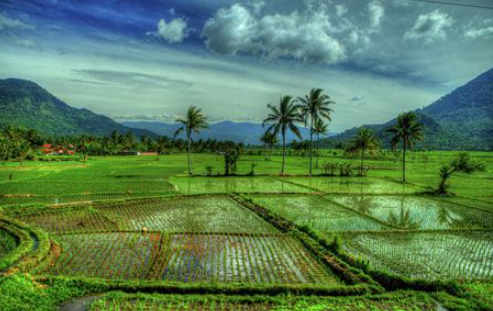TravelBestForyYou.com
Indonesia eco-tourism – Indonesia – a name that conjures images of pristine beaches, lush rainforests, and vibrant cultures. But let me tell you, my friend, there’s so much more to this archipelagic wonder than meets the eye.
As someone who’s had the privilege of traversing its 17,000+ islands (okay, maybe not all of them, but a girl can dream, right?), I can attest that Indonesia’s eco-tourism scene is like a hidden treasure chest just waiting to be cracked open.
Picture this: You’re standing on the edge of a verdant rice terrace in Bali, the morning mist still clinging to the air like nature’s own gossamer veil. The sun peeks over the horizon, painting the sky in hues that would make even the most jaded artist weep with joy. And that’s just the appetizer in the grand feast that is Indonesia’s eco-tourism.
Now, I know what you’re thinking. “Eco-tourism? Isn’t that just a fancy way of saying ‘sleeping in a treehouse and eating bugs’?” Well, hold onto your sarongs, folks, because we’re about to embark on a journey that’ll make you rethink everything you thought you knew about sustainable travel.
Indonesia eco-tourism
Indonesia’s eco-tourism isn’t just a trend; it’s a revolution. It’s about immersing yourself in nature without leaving a Godzilla-sized carbon footprint. It’s about supporting local communities while gawking at orangutans swinging through the canopy.
It’s about snorkeling in waters so clear you’ll swear you’ve developed superhuman vision, all while knowing your presence is helping to preserve these marine wonderlands.
But here’s the kicker – Indonesia’s approach to eco-tourism is as diverse as its 300+ ethnic groups. From the mist-shrouded volcanoes of Java to the untouched beaches of the Forgotten Islands, each destination offers a unique flavor of sustainable adventure. And let me tell you, it’s a buffet you’ll want to gorge yourself on.
Unveiling the Past: 10 Best Vacation Spots for History Enthusiasts
The Green Heart of Sumatra: Where Tigers Roam and Forests Whisper
Let’s kick off our eco-adventure in Sumatra, shall we? This island is like the Amazonian cousin of Indonesia – wild, untamed, and bursting with biodiversity. Gunung Leuser National Park, a UNESCO World Heritage site, is the crown jewel of Sumatra’s eco-tourism offerings. It’s one of the last places on Earth where you can spot Sumatran tigers, orangutans, and rhinos in their natural habitat. Talk about a triple threat!
But here’s the thing – visiting Gunung Leuser isn’t just about ticking off your wildlife bucket list. It’s about understanding the delicate balance between conservation and community development.
Local guides, many of whom are former loggers or poachers, now lead treks through the jungle, sharing their intimate knowledge of the forest while earning a sustainable income. It’s a win-win situation that’ll make your heart grow three sizes, Grinch-style.
And let’s not forget about the accommodations. Eco-lodges in Sumatra range from basic (but charming) bamboo huts to luxurious treehouses that’ll make you feel like a modern-day Tarzan or Jane. My personal favorite? A riverside retreat where you can fall asleep to the sound of gibbons serenading the moon and wake up to the aroma of locally-grown coffee wafting through your window. Heaven on Earth? You bet your biodegradable soap it is!
Bali: Beyond the Beaches and into the Green
Now, I know what you’re thinking. “Bali? Eco-tourism? Isn’t it all just infinity pools and Instagram influencers?” Oh, my sweet summer child, how wrong you are. While it’s true that parts of Bali have been loved a little too hard by tourism, the island of the gods is fighting back with a vengeance – a green vengeance, that is.
Take Ubud, for instance. Once upon a time, it was a sleepy artist’s village. Then Eat, Pray, Love happened, and suddenly everyone and their yoga mat wanted a piece of the action. But Ubud has risen to the challenge, becoming a hub for sustainable tourism that would make even the most ardent eco-warrior swoon.
Imagine staying in a bamboo villa that looks like it was designed by elves on an architectural bender. These stunning structures, pioneered by places like the Green Village, are not only jaw-droppingly beautiful but also completely sustainable.
They’re built using local materials, powered by renewable energy, and designed to have minimal impact on the surrounding environment. It’s like living in a treehouse, but with Wi-Fi and gourmet vegan cuisine.
But Bali’s eco-tourism isn’t just about where you lay your head at night. It’s about immersing yourself in the island’s rich culture and natural beauty in a way that gives back. Join a community-led reforestation project in the central highlands, where you can plant native trees and learn about traditional Balinese farming techniques.
Or take a cooking class that uses only locally-sourced, organic ingredients – trust me, you haven’t lived until you’ve made your own sambal from scratch using chili peppers picked that morning.
Raja Ampat: Diving into Conservation
If Sumatra is the lungs of Indonesia’s eco-tourism, then Raja Ampat is its beating heart. This archipelago in West Papua is the holy grail for divers and marine enthusiasts, boasting the highest recorded marine biodiversity on the planet. We’re talking more species of fish and coral than you can shake a snorkel at.
But here’s the real kicker – Raja Ampat isn’t just a pretty face. It’s at the forefront of marine conservation efforts in Indonesia. The local government, in partnership with NGOs and eco-resorts, has established a network of Marine Protected Areas (MPAs) that would make Jacques Cousteau weep with joy.
Staying in Raja Ampat is an experience in itself. Eco-resorts here range from rustic beach bungalows to over-water villas that’ll make you feel like aquatic royalty. But don’t let the luxury fool you – these places mean business when it comes to sustainability.
Many use solar power, collect rainwater, and have strict policies on waste management. Some even have their own coral restoration projects, where you can help plant baby corals and contribute to the health of the reef.
But the real magic happens underwater. Imagine diving into waters so clear you’ll think you’re floating in air, surrounded by schools of fish so colorful they look like they’ve been tie-dyed.
Spot manta rays gliding gracefully through the blue, their wingspans wider than your outstretched arms. And if you’re lucky (and quiet), you might even catch a glimpse of the elusive wobbegong shark, a creature so bizarre-looking it seems like it was designed by a committee of drunk marine biologists.
Komodo National Park: Where Dragons Roam and Reefs Thrive
Let’s take a moment to appreciate the sheer audacity of Komodo National Park. Where else in the world can you find prehistoric-looking lizards lounging on pink beaches, surrounded by some of the most diverse coral reefs on the planet? It’s like Mother Nature decided to throw all her best ideas into one place and said, “Let’s see what happens!”
Komodo’s approach to eco-tourism is as unique as its scaly inhabitants. The park has implemented a strict quota system to limit the number of visitors, ensuring that the dragons and their habitat aren’t overwhelmed by selfie-stick wielding tourists. And let me tell you, there’s something thrilling about knowing you’re one of the lucky few to set foot on these islands each day.
But Komodo isn’t just about the dragons (although they are pretty darn cool). The marine life here is off the charts. Dive into the waters around Komodo and you’ll find yourself in a technicolor wonderland of soft corals, sea fans, and more fish species than you can count. And if you’re really lucky, you might even spot a dugong – the gentle sea cow that inspired mermaid legends of old.
Eco-lodges in and around Komodo take sustainability to the next level. Some are built entirely of reclaimed wood, others generate their own electricity through solar and wind power. There’s even one that desalinates its own water, proving that luxury and sustainability can go hand in hand like peanut butter and jelly (or, in this case, like nasi and goreng).
The Road Less Traveled: Off-the-Beaten-Path Eco-Adventures
Now, for those of you who like your adventures with a side of “where the heck am I?”, Indonesia’s got you covered. Let’s talk about some eco-tourism destinations that’ll make your friends back home green with envy (and maybe a little confused).
First up, the Togean Islands in Central Sulawesi. This remote archipelago is like the Maldives’ quirky cousin – all pristine beaches and crystal-clear waters, but with a distinctly Indonesian flavor.
Here, you can stay in eco-resorts that are more like small villages, complete with their own organic gardens and conservation projects. Snorkel with sea turtles by day, and by night, witness the magic of bioluminescent plankton turning the ocean into a starry sky.
Or how about Tangkahan in North Sumatra? This former logging community has reinvented itself as an eco-tourism haven, where you can wash rescued elephants in the river, trek through pristine rainforest, and stay in jungle lodges that seem to have grown organically from the forest floor. It’s raw, it’s real, and it’s exactly the kind of place that’ll make you feel like you’ve stumbled upon a secret paradise.
And for those who like their eco-adventures with a side of culture, there’s Wae Rebo in Flores. This traditional Manggarai village, nestled high in the mountains, offers homestays in their distinctive cone-shaped houses.
But it’s not just about experiencing traditional life – the village is actively involved in reforestation efforts, and visitors can participate in tree-planting activities. It’s a chance to connect with a unique culture while also giving back to the environment.
The Future of Indonesia’s Eco-Tourism: Challenges and Opportunities
As we wrap up our whirlwind tour of Indonesia’s eco-tourism scene, it’s worth taking a moment to consider the road ahead. Because let’s face it, it’s not all sunshine and sustainably sourced rainbows.
Indonesia faces some serious environmental challenges. Deforestation, plastic pollution, and the impacts of climate change are all very real threats. But here’s the thing – eco-tourism could be a powerful tool in combating these issues. By providing economic incentives for conservation, it can help shift the paradigm from exploitation to protection.
The Indonesian government seems to be catching on. In recent years, there’s been a push to develop sustainable tourism across the archipelago. Initiatives like the “10 New Balis” project aim to spread tourism (and its economic benefits) more evenly across the country, with a focus on sustainability and community involvement.
But it’s not just up to the government. As travelers, we have a responsibility too. By choosing eco-friendly accommodations, supporting local communities, and being mindful of our impact, we can help ensure that Indonesia’s natural wonders are preserved for generations to come.
Incredible Top Reasons to Visit The City Of Goa: A Paradise Like No Other
Conclusion
So there you have it, folks – a whirlwind tour of Indonesia’s eco-tourism scene that barely scratches the surface of what this incredible country has to offer. From the misty jungles of Sumatra to the technicolor reefs of Raja Ampat, Indonesia is a treasure trove of sustainable adventures just waiting to be discovered.
But remember, eco-tourism isn’t just about ticking off bucket list experiences or getting that perfect Instagram shot (although let’s be real, you’re going to get some killer photos). It’s about connecting with nature, supporting local communities, and being part of a movement that’s working to protect some of the most biodiverse ecosystems on the planet.
So the next time you’re planning a trip, why not consider Indonesia? Trust me, your inner eco-warrior (and your social media feed) will thank you. Just don’t blame me if you end up extending your visa and “forgetting” to come home. After all, once you’ve experienced the magic of Indonesia’s eco-tourism, everywhere else just seems a little… well, less green.





